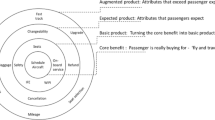Abstract
Modeling air carrier demand is instrumental to understanding the relative importance of competitive forces that shape the airline environment and determine a carrier's market share. This paper develops a conceptual framework for analyzing carrier demand in a competitive context and applies that framework to study air carrier choice. This framework can be used by carriers to assess the market share and revenue implications of service design, pricing, marketing, and promotional strategies.
We adopt an individual traveler choice approach to identify and measure the relative importance of factors which influence air travel demand. Travelers' patterns of air travel, perceptions of carrier service, frequent-flyer program membership, and carrier choice behavior are used to estimate models of individual carrier choice. These models indicate the importance of carrier presence in the origin market, carrier service in a city pair market (share of flights), carrier quality of service reflected in ratings by individual travelers, and traveler loyalty reflected in frequent-flyer program membership on carrier choice.
The importance of these variables and the specific quantitative relationship estimated, can be used to estimate the market share impact of service design, pricing, marketing, and promotional changes. The empirical results of this study demonstrate the dramatic impact of frequent-flyer program participation on carrier choice for individual flights. These effects are particularly strong among the most important air carrier market, the frequent business traveler.
Similar content being viewed by others
References
Abrahams M (1983) A Service Quality Model of Air Travel Demand: An Empirical Study.Transportation Research A 17A: 385–393.
Belobaba PP (1987)Air Travel Demand and Airline Seat Inventory Management. Unpublished Ph.D. Dissertation, Massachusetts Institute of Technology.
Borenstein S (1992) The Evolution of US Airline Competition.Journal of Economic Perspectives 6: 45–73.
Borenstein S (1988)The Competitive Advantage of a Dominant Airline. Institute of Public Policy Studies, Discussion Paper No. 280, University of Michigan.
Brown SM & Watkins WS (1968) The Demand for Air Travel: A Regression Study of Time-Series and Cross-Sectional Data in the US Domestic Market.Highway Research Record 213: 21–34.
Chandrashaker VS (1989)Passenger Behavior when Denied First Preference. M.Sc. Thesis, Northwestern University.
Churchill GA (1983)Marketing Research: Methodological Foundations. The Dryden Press, Chicago.
de Vany AS (1974) The Revealed Value of Time in Air Travel.Review of Economics and Statistics 56: 77–82.
Douglas GW & Miller JC III (1974)Economic Regulation of Domestic Air Transport: Theory and Policy. Washington DC: The Brookings Institution.
Gronau R (1967)The Effect of Traveling Time on the Demand for Passenger Airline Transportation. Unpublished Ph.D. Dissertation, Columbia University.
Hensher DA & Louvierre JJ (1983) Individual Preferences for International Air Fares.Journal of Transport Economics and Policy XVII: 225–246.
Howard J (1989) U.S. Aircraft Manufacturers' Methodology.Aviation Forecasting Methodology, Transportation Research Circular 348: 33–34.
Ippolito RA (1981) Estimating Air Travel Demand with Quality of Service Variables.Journal of Transport Economics and Policy pp 7–15.
Kanafani A (1980) Price Elasticities of Non-business Air Travel Demand.Transportation Engineering Journal ofASCE 106: 217–225.
Koppelman FS & Pas E (1980) Travel Choice Behavior: Models of Perceptions, Feelings, Preference and Choice.Transportation Research Record 765.
Lee AO (1990)Airline Reservations Forecasting: Probabilistic and Statistical Models of the Booking Process. Unpublished PhD Dissertation, Massachusetts Institute of Technology.
Mayer CJ (1989) Federal Aviation Administration Methodology.Aviation Forecasting Methodology, Transportation Research Circular 348: 9–29.
Nason SD (1981)The Airline Preference Problem: An Application of Disaggregate Logit. Presented at the AGIFORS Symposium, Santa Barbara, California.
Oberhausen PJ & Koppelman FS (1982) Time-series Analysis of Intercity Air Travel Volume.Transportation Research Record 840: 15–21.
Proussaloglou KE & Koppelman FS (1989)Use of Travelers' Attitudes in Rail Service Design. Transportation Research Record 1221.
Schumann HO (1986)Oligopolistic Nonlinear Pricing — A Study of Trading Stamps and Airline Frequent Flyer Programs. Unpublished Ph.D. Dissertation, Northwestern University.
Taneja NK (1978)Airline Traffic Forecasting: A Regression Analysis Approach. Massachusetts: Lexington Books.
Toh RS & Hu MY (1988) Frequent Flier Programs: Passenger Attributes and Attitudes.Transportation Journal, pp 12–22.
United States General Accounting Office (1990)Airline Competition: Industry Operating and Marketing Practices Limit Market Entry. GAO/RCED-90-147.
Verleger PK (1972) Models of the Demand for Air Transportation.The Bell Journal of Economics and Management Science 3: 437–457.
Author information
Authors and Affiliations
Rights and permissions
About this article
Cite this article
Proussaloglou, K., Koppelman, F. Air carrier demand. Transportation 22, 371–388 (1995). https://doi.org/10.1007/BF01098165
Accepted:
Issue Date:
DOI: https://doi.org/10.1007/BF01098165




